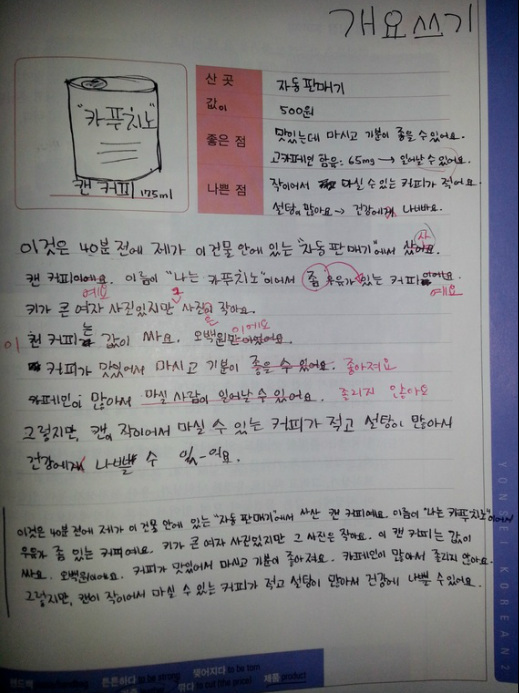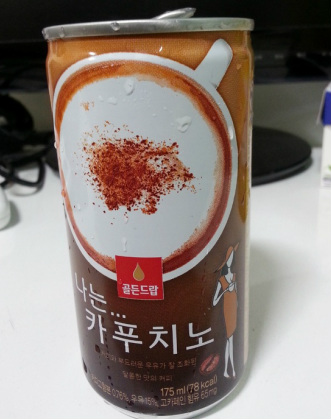Here is an assignment from my Korean class, kind of a free writing activity (for once). Choose a product and write a little summary of it. Guidelines, simple: Where was it bought? / Price? / Good points? / Bad points?
I wrote what is in black. Red is the teacher’s. Below is the final text in Korean (corrected) with my English translation.
I wrote what is in black. Red is the teacher’s. Below is the final text in Korean (corrected) with my English translation.
|
캔 커피 [개요쓰기]
이것은 40분 전에 제가 이 건물 안에 있는 자동판매기에서 산 캔 커피예요. 이름이 “나는…카푸치노”이어서 우유가 좀 있는 커피예요. 키가 큰 여자 사진있지만, 그 사진은 작아요. 이 캔 커피는 값이 싸요. 오백원이에요. 커피가 맛있어서 마시고 기분이 좋아져요. 카페인이 많아서 졸리지 않아요. 그렇지만 캔이 작이어서 마실 수 있는 커피가 적고 설탕이 많아서 건강에 나쁠 수 있어요. Can of Coffee [Product Summary] (Translation) This is a can of coffee which was bought by me forty minutes ago in a vending machine in this building. As its name is “I Am…Cappuccino” it must be the kind of coffee which has some milk in it. There is a picture of a tall woman on the can, but the picture is small. This can of coffee is sold at a cheap price. It is only 500 Korean Won [50 U.S. cents]. As the coffee tastes good, after drinking it you’ll feel better. There is a lot of caffeine, so you won’t feel drowsy. However, the can is a bit small so there is not much coffee to drink, and furthermore there’s lots of sugar, so it may be a bad for your health. |
Looking back on this little assignment, I can make a few other general comments:
(1) Not Really From a Vending Machine. I actually bought it in the building’s convenience store with my Japanese classmate Toru씨. I’m not sure if I didn’t remember this, or whether I just really wanted to use the word “자동판매기” (jah-dong-pahn-meggi, vending machine) which I think sounds funny.
(2) Sugar? In fact, I didn’t check the sugar content. I was in a rush to finish in the ten minutes allotted. I just assumed.
(3) A Lot of Caffeine? The can includes 65mg of caffeine, as you’ll see in the photo. In Korea they always put the amount of caffeine on the front of the caffeinated products, which I find nice. If you’re like me, you try to maximize the caffeine-per-dollar value. I don’t really think 65mg is “a lot” of caffeine (as I wrote in the assignment). For a man of my size (185 pounds or 84 kilograms, I think), my impression is that it will start to noticeably perk you up only well above the 100mg level.
(4) The Can is Tiny. It can fit in your pocket. The can is 175 ml, a bit less than 6 ounces, so half the volume of the smallest soda cans we sell. In my memory in the USA, I don’t remember such tiny cans of drinks being sold to adults. Judging by how common they are in Korea, they do brisk business.
(1) Not Really From a Vending Machine. I actually bought it in the building’s convenience store with my Japanese classmate Toru씨. I’m not sure if I didn’t remember this, or whether I just really wanted to use the word “자동판매기” (jah-dong-pahn-meggi, vending machine) which I think sounds funny.
(2) Sugar? In fact, I didn’t check the sugar content. I was in a rush to finish in the ten minutes allotted. I just assumed.
(3) A Lot of Caffeine? The can includes 65mg of caffeine, as you’ll see in the photo. In Korea they always put the amount of caffeine on the front of the caffeinated products, which I find nice. If you’re like me, you try to maximize the caffeine-per-dollar value. I don’t really think 65mg is “a lot” of caffeine (as I wrote in the assignment). For a man of my size (185 pounds or 84 kilograms, I think), my impression is that it will start to noticeably perk you up only well above the 100mg level.
(4) The Can is Tiny. It can fit in your pocket. The can is 175 ml, a bit less than 6 ounces, so half the volume of the smallest soda cans we sell. In my memory in the USA, I don’t remember such tiny cans of drinks being sold to adults. Judging by how common they are in Korea, they do brisk business.



I get this by email from a correspondent in response to my comment that “In my memory in the USA, I don’t remember such tiny cans of drinks being sold to adults”.
“The smallest Frappuccino bottles I found [in the USA] are 9.5 oz (281 ml). They come in 4-packs, normally $5.99 a pack. On sale this week for $3.99 so I bought one. They are Starbucks, but there are also house brands at a more reasonable cost. FYI, 200 calories per bottle, total fat 3 g, cholesterol 15 mg, sodium 100 mg, carbohydrates 37 g (includes sugar 32 g), no fiber, protein 6 g, calcium 20% daily value. Contains brewed coffee, reduced fat milk, sugar, maltodextrin, pectin, ascorbic acid. At least that’s what the bottle told me… You are right that 65 mg of caffeine is not much.”